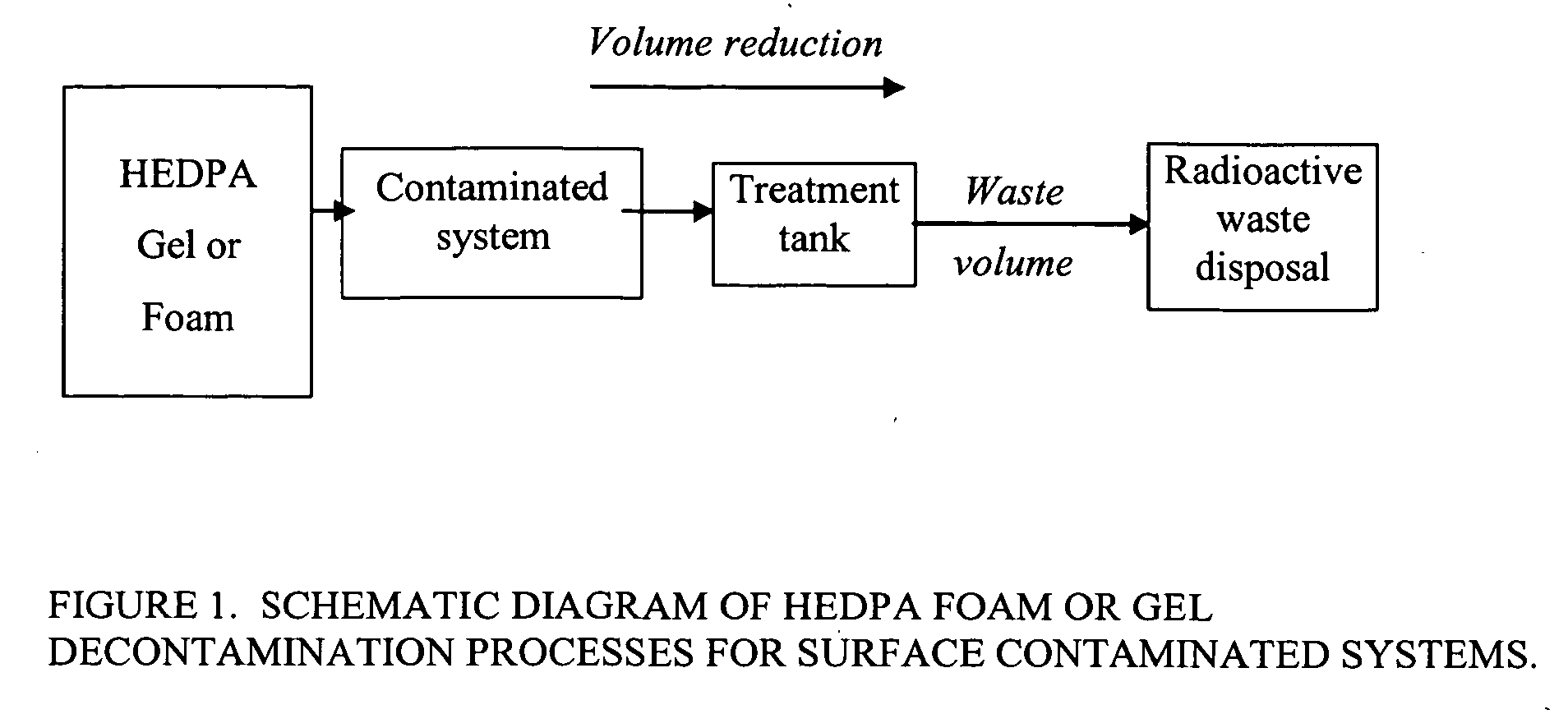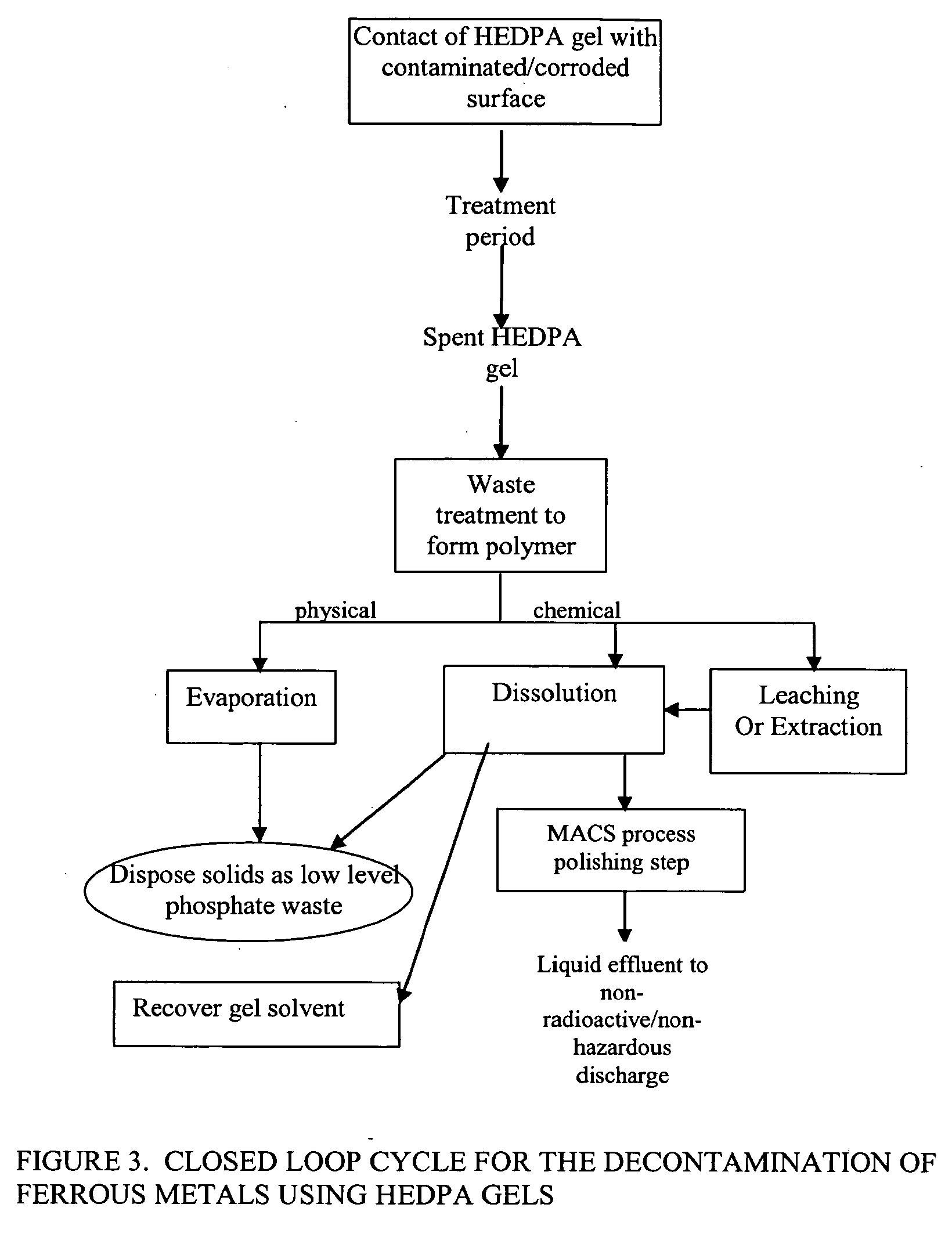Foam and gel methods for the decontamination of metallic surfaces
a technology of foam and gel, applied in the direction of hollow article cleaning, cleaning using liquids, nuclear engineering, etc., to achieve the effects of high stability, strong chelating ability, and high dissolving
- Summary
- Abstract
- Description
- Claims
- Application Information
AI Technical Summary
Benefits of technology
Problems solved by technology
Method used
Image
Examples
example 1
[0061] A corroded carbon steel sheet (AISI type 1010 carbon steel, 10×15 cm) was obtained from the Naval Warfare Research Center, Carderock Division, U.S. Navy. The extensive corrosion of the surface of the as-received carbon steel sheet was brown-red and loose. This suggests the presence of predominantly amorphous hydrated Fe2O3 (as FeO and Fe3O4 are black, and hematite, α-Fe2O3, will not dissolve in HEDPA alone). To better observe changes in the metal surface, half the sample was submerged in the HEDPA gel solution at 90° C. for a given time, creating a clear reaction or prewetting surface interface. Following testing, the sample was removed, the treated half was rinsed in warm (50° C.) deionized water, and air-dried for further analysis.
[0062] Various gel solutions as described in TABLE 6 containing HEDPA in glycerine as the solvent were heated to 100° C. after removing from the oven the viscosity was less than ambient temperature viscosity, gel was allowed to cool and applied t...
example 2
[0065] HEDPA on silica support provides a unique method to both achieve decontamination in a gel solution and at the same time have a material that can be thermal transformed directly into a stable final vitrified or glass waste form.
[0066] HEDPA based gels containing HEDPA grafted to a silica support were prepared by mixing with a 4.2 M HEDPA solution. The grafted silica support was characterized by H+ capacity of 1.3 mmol / g and P capacity of 0.68 mmol / g, with 50-100 mesh size particles. Various Silica gel / HEDPA wt % were studied at ambient temperature. Gel samples were applied to Navy carbon steel with some samples treated at ambient temperature and others were heated a 100° C. for 4 hours, all samples were allowed to cool and evaluated at room temperature. TABLE 9 shows the results of the Silica gel / HEDPA based gels. The silica gel / HEDPA ratios lower than 0.8 had the lowest viscosity and did not behave as a traditional gel. The optimal concentration and the best clean up of the ...
example 3
[0067] HEDPA based decontamination solutions were studied with gels which have a sponge effect of absorption of liquid solution. The crosslinked copolymeric gel material used was 70 wt % / 30 wt % polyacrylamide / polyacrylate (PAM / PAC) polymer with mm grain size where the polyacrylamide polymer and the polyacrylate polymer have chemical structures of —(RCHCONH2)n— and of —(RCHCR′COOX)n—, respectively, where n can vary from 2 to 10,000. It retains approximately 50 g water per g of polymer. TABLE 10 shows the concentrations of HEDPA with AHA used. The polymeric gel was mixed and heated at 50° C. to accelerate the gelling process. Once the liquid was contained in the solid swollen gel, samples were used to clean carbon steel samples at 90° C. for one hour. The samples were taken out of the oven and allowed to cool at room temperature. The samples were extremely free of oxide at the locations where the gel was in contact with the surface.
TABLE 10Gel formulation using 70 / 30 PAM / PAC with H...
PUM
| Property | Measurement | Unit |
|---|---|---|
| Temperature | aaaaa | aaaaa |
| Temperature | aaaaa | aaaaa |
| Temperature | aaaaa | aaaaa |
Abstract
Description
Claims
Application Information
 Login to View More
Login to View More - R&D
- Intellectual Property
- Life Sciences
- Materials
- Tech Scout
- Unparalleled Data Quality
- Higher Quality Content
- 60% Fewer Hallucinations
Browse by: Latest US Patents, China's latest patents, Technical Efficacy Thesaurus, Application Domain, Technology Topic, Popular Technical Reports.
© 2025 PatSnap. All rights reserved.Legal|Privacy policy|Modern Slavery Act Transparency Statement|Sitemap|About US| Contact US: help@patsnap.com



